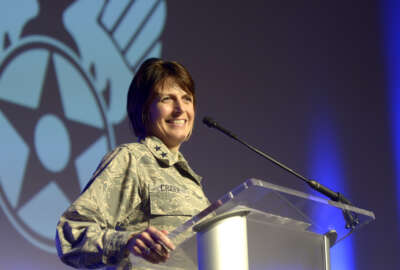
The Space Force will have trouble accessing more than $15 billion without congressional appropriations.
The military services are no strangers to warning and complaining to Congress about continuing resolutions causing issues with funding, and therefore, future plans.
But this year lawmakers have one more military service pulling on their ears about passing appropriations: the Space Force.
The youngest service, still shy of a year old, is warning that it will have some serious growing pains if Congress can’t get it the $15.4 billion the Defense Department requested for the military branch in 2021.
“The long-term CR path won’t be good for our service,” Chief of Space Operations Gen. Jay Raymond told reporters Tuesday during the Air Force Association’s Virtual Air, Sea, Space and Cyber Conference. “There’s three really big issues a long-term CR would have on the Space Force.”
Those issues include a technicality where the Air Force is allocated the money for the Space Force and then it is transferred to the new service. That money would stay with the Air Force in a CR because no new start programs would be allowed and last year the Space Force was only allocated $40 million.
Outside of hanging up the whole budget, Raymond said the service needs operations and maintenance funds to take care of the missions it’s already started. The Space Force has already launched some satellites into orbit and sent up its secretive X-37B “space plane.”
“We’ve got to get the rest of those dollars now that we have our service up and running,” Raymond said.
Finally, Raymond said a CR could affect some of the programs the Space Force has already adopted. Those include GPS III, which has more precision and anti-jamming technologies than the previous iteration.
The Space Force does have one option that could help it during a CR, but it would need congressional approval. The service could request an anomaly, which would fund the service in specifically requested areas while the other parts of the budget still abide by the rules of a CR.
Air Force Secretary Barbra Barrett said the Air Force has not worked with Congress yet on possible anomalies.
Meanwhile, the service is still continuing to set itself up. The Space Force swore in hundreds of new troops on Tuesday and will bring in 2,400 more by the end of the month. More than 8,500 airmen volunteered to transfer over.
Part of setting up the new service is making it “lean and agile,” one of the requirements lawmakers made when setting up the Space Force. The point of that is to cut back on bureaucracy and keep the branch from becoming bloated with unneeded funds.
One way Raymond said he is doing that is by pushing down acquisition authority to lower levels. The Space Force’s contracting authority will not be housed in the Pentagon, but rather in field offices to be near the systems and their needs.
“I want the expert operating or developing our capabilities to be very, very close to a decision maker,” Raymond said. “I don’t want them to have to go through five or six different layers of command to get to a decision. We want to be able to do that fast.”
The Space Force is also trying to streamline the number of offices that have their hands in space capabilities.
“If you look at missile warning architecture, there are a bunch of different organizations that have a role in that — and if you look at force design, there’s close to 30 different organizations that have a hand in that,” Raymond said. “Now that we’ve worked the organization piece of the Space Force, it’s now time to take that next step and to look upward and flatten that bureaucracy and reduce duplication.”
Copyright © 2024 Federal News Network. All rights reserved. This website is not intended for users located within the European Economic Area.
Scott Maucione is a defense reporter for Federal News Network and reports on human capital, workforce and the Defense Department at-large.
Follow @smaucioneWFED
